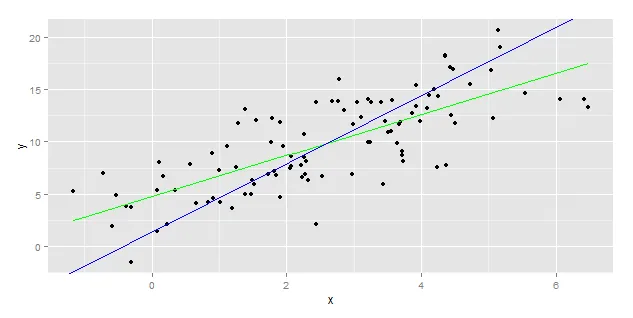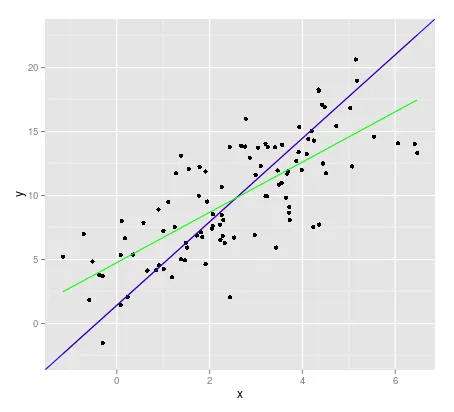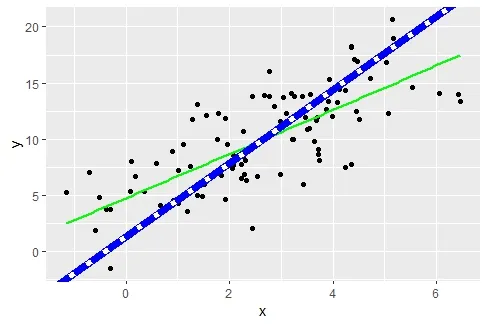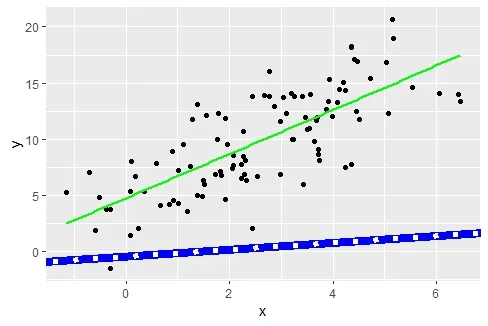“MethComp”包似乎不再维护(已从CRAN中删除)。
Russel88/COEF允许使用
method="tls"将正交回归线添加到
stat_/
geom_summary中。
基于此,以及
wikipedia:Deming_regression,我创建了以下函数,允许使用除1之外的噪声比率:
deming.fit <- function(x, y, noise_ratio = sd(y)/sd(x)) {
if(missing(noise_ratio) || is.null(noise_ratio)) noise_ratio <- eval(formals(sys.function(0))$noise_ratio)
delta <- noise_ratio^2
x_name <- deparse(substitute(x))
s_yy <- var(y)
s_xx <- var(x)
s_xy <- cov(x, y)
beta1 <- (s_yy - delta*s_xx + sqrt((s_yy - delta*s_xx)^2 + 4*delta*s_xy^2)) / (2*s_xy)
beta0 <- mean(y) - beta1 * mean(x)
res <- c(beta0 = beta0, beta1 = beta1)
names(res) <- c("(Intercept)", x_name)
class(res) <- "Deming"
res
}
deming <- function(formula, data, R = 100, noise_ratio = NULL, ...){
ret <- boot::boot(
data = model.frame(formula, data),
statistic = function(data, ind) {
data <- data[ind, ]
args <- rlang::parse_exprs(colnames(data))
names(args) <- c("y", "x")
rlang::eval_tidy(rlang::expr(deming.fit(!!!args, noise_ratio = noise_ratio)), data, env = rlang::current_env())
},
R=R
)
class(ret) <- c("Deming", class(ret))
ret
}
predictdf.Deming <- function(model, xseq, se, level) {
pred <- as.vector(tcrossprod(model$t0, cbind(1, xseq)))
if(se) {
preds <- tcrossprod(model$t, cbind(1, xseq))
data.frame(
x = xseq,
y = pred,
ymin = apply(preds, 2, function(x) quantile(x, probs = (1-level)/2)),
ymax = apply(preds, 2, function(x) quantile(x, probs = 1-((1-level)/2)))
)
} else {
return(data.frame(x = xseq, y = pred))
}
}
fix_plot_limits <- function(p) p + coord_cartesian(xlim=ggplot_build(p)$layout$panel_params[[1]]$x.range, ylim=ggplot_build(p)$layout$panel_params[[1]]$y.range)
演示:
library(ggplot2)
library(COEF)
fix_plot_limits(
ggplot(data.frame(x = (1:5) + rnorm(100), y = (1:5) + rnorm(100)*2), mapping = aes(x=x, y=y)) +
geom_point()
) +
geom_smooth(method=deming, aes(color="deming"), method.args = list(noise_ratio=2)) +
geom_smooth(method=lm, aes(color="lm")) +
geom_smooth(method = COEF::tls, aes(color="tls"))

创建于2019年12月4日,使用
reprex package(v0.3.0)。





slope和intercept传递到geom_abline,或者使用这里展示的方法创建自己的方法。 - user20650